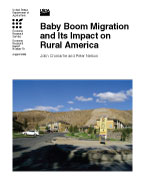Baby Boom Migration and Its Impact on Rural America
- by John Cromartie and Peter B. Nelson
- 8/10/2009
Overview
Members of the baby boom cohort, now 45-63 years old, are approaching a period in their lives when moves to rural and small-town destinations increase. An analysis of age-specific, net migration during the 1990s reveals extensive shifts in migration patterns as Americans move through different life-cycle stages. Assuming similar age patterns of migration, this report identifies the types of nonmetropolitan counties that are likely to experience the greatest surge in baby boom migration during 2000-20 and projects the likely impact on the size and distribution of retirement-age populations in destination counties. The analysis finds a significant increase in the propensity to migrate to nonmetro counties as people reach their fifties and sixties and projects a shift in migration among boomers toward more isolated settings, especially those with high natural and urban amenities and lower housing costs. If baby boomers follow past migration patterns, the nonmetro population age 55-75 will increase by 30 percent between now and 2020.
Download
-
Entire report
Download PDF -
Report summary
Download PDF -
Abstract, Contents, and Summary
Download PDF -
Introduction
Download PDF -
Why Is Baby Boom Migration Important to Rural America?
Download PDF -
Migration as a Life-Cycle Event
Download PDF -
Migration Patterns of the Baby Boom Cohort
Download PDF -
Factors Driving Age-Specific Net Migration, 1990-2000
Download PDF -
Net Migration Projections, 2000-20
Download PDF -
Conclusion
Download PDF -
References
Download PDF -
Appendix: Regression Analysis and Population Projections
Download PDF -
Download ERR79.zip
Download ZIP

